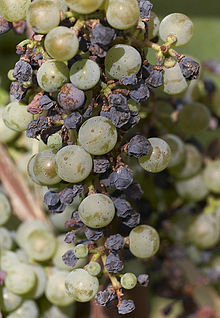| Guignardia bidwellii | |
|---|---|
| Scientific classification | |
| Domain: | Eukaryota |
| Kingdom: | Fungi |
| Division: | Ascomycota |
| Class: | Dothideomycetes |
| Order: | Botryosphaeriales |
| Family: | Botryosphaeriaceae |
| Genus: | Guignardia |
| Species: | G. bidwellii
|
| Binomial name | |
| Guignardia bidwellii (Ellis) Viala & Ravaz (1892)
| |
| Synonyms | |
|
Naemospora ampelicida Engelm. [as 'Naemaspora'] (1863) | |
| Black rot of grape | |
|---|---|
 damages on fruits | |
| Causal agents | Guignardia bidwellii |
| Hosts | Grapevine |
| Vectors | rain |
| EPPO Code | GUIGBI |
| Distribution | originated from eastern North America, but now occurs in portions of Europe, South America and Asia |
| Symptoms | small, brown circular lesions on leaves, "mummies" on fruits |
| Treatment | choice of right cultivars, mixture of cultural and chemical control practices |

Grape black rot is a fungal disease caused by an ascomycetous fungus, Guignardia bidwellii, that attacks grape vines during hot and humid weather. “Grape black rot originated in eastern North America, but now occurs in portions of Europe, South America, and Asia. It can cause complete crop loss in warm, humid climates, but is virtually unknown in regions with arid summers.”[1] The name comes from the black fringe that borders growing brown patches on the leaves. The disease also attacks other parts of the plant, “all green parts of the vine: the shoots, leaf and fruit stems, tendrils, and fruit. The most damaging effect is to the fruit”.[2]
Grape black rot affects many grape growers throughout the World, therefore, it is important to understand the disease life cycle and environmental conditions to best manage the disease. Once infection takes place, different methods are available to control the disease.